Ziqiao Ma
Michael Pokorny
From Behavioral Performance to Internal Competence: Interpreting Vision-Language Models with VLM-Lens
Oct 02, 2025Abstract:We introduce VLM-Lens, a toolkit designed to enable systematic benchmarking, analysis, and interpretation of vision-language models (VLMs) by supporting the extraction of intermediate outputs from any layer during the forward pass of open-source VLMs. VLM-Lens provides a unified, YAML-configurable interface that abstracts away model-specific complexities and supports user-friendly operation across diverse VLMs. It currently supports 16 state-of-the-art base VLMs and their over 30 variants, and is extensible to accommodate new models without changing the core logic. The toolkit integrates easily with various interpretability and analysis methods. We demonstrate its usage with two simple analytical experiments, revealing systematic differences in the hidden representations of VLMs across layers and target concepts. VLM-Lens is released as an open-sourced project to accelerate community efforts in understanding and improving VLMs.
AimBot: A Simple Auxiliary Visual Cue to Enhance Spatial Awareness of Visuomotor Policies
Aug 11, 2025Abstract:In this paper, we propose AimBot, a lightweight visual augmentation technique that provides explicit spatial cues to improve visuomotor policy learning in robotic manipulation. AimBot overlays shooting lines and scope reticles onto multi-view RGB images, offering auxiliary visual guidance that encodes the end-effector's state. The overlays are computed from depth images, camera extrinsics, and the current end-effector pose, explicitly conveying spatial relationships between the gripper and objects in the scene. AimBot incurs minimal computational overhead (less than 1 ms) and requires no changes to model architectures, as it simply replaces original RGB images with augmented counterparts. Despite its simplicity, our results show that AimBot consistently improves the performance of various visuomotor policies in both simulation and real-world settings, highlighting the benefits of spatially grounded visual feedback.
4D-LRM: Large Space-Time Reconstruction Model From and To Any View at Any Time
Jun 23, 2025Abstract:Can we scale 4D pretraining to learn general space-time representations that reconstruct an object from a few views at some times to any view at any time? We provide an affirmative answer with 4D-LRM, the first large-scale 4D reconstruction model that takes input from unconstrained views and timestamps and renders arbitrary novel view-time combinations. Unlike prior 4D approaches, e.g., optimization-based, geometry-based, or generative, that struggle with efficiency, generalization, or faithfulness, 4D-LRM learns a unified space-time representation and directly predicts per-pixel 4D Gaussian primitives from posed image tokens across time, enabling fast, high-quality rendering at, in principle, infinite frame rate. Our results demonstrate that scaling spatiotemporal pretraining enables accurate and efficient 4D reconstruction. We show that 4D-LRM generalizes to novel objects, interpolates across time, and handles diverse camera setups. It reconstructs 24-frame sequences in one forward pass with less than 1.5 seconds on a single A100 GPU.
Can Vision Language Models Infer Human Gaze Direction? A Controlled Study
Jun 04, 2025Abstract:Gaze-referential inference--the ability to infer what others are looking at--is a critical component of a theory of mind that underpins natural human-AI interaction. In a controlled study, we evaluated this skill across 111 Vision Language Models (VLMs) using photos taken with manipulated difficulty and variability, comparing performance with that of human participants (N = 65), and analyzed behaviors using mixed-effects models. We found that 94 of the 111 VLMs failed to do better than random guessing, while humans achieved near-ceiling accuracy. VLMs even respond with each choice almost equally frequently. Are they randomly guessing? Although most VLMs struggle, when we zoom in on five of the top-tier VLMs with above-chance performance, we find that their performance declined with increasing task difficulty but varied only slightly across different prompts and scene objects. These behavioral features cannot be explained by considering them as random guessers. Instead, they likely use a combination of heuristics and guessing such that their performance is subject to the task difficulty but robust to perceptual variations. This suggests that VLMs, lacking gaze inference capability, have yet to become technologies that can naturally interact with humans, but the potential remains.
Vision-Language Models Are Not Pragmatically Competent in Referring Expression Generation
Apr 22, 2025
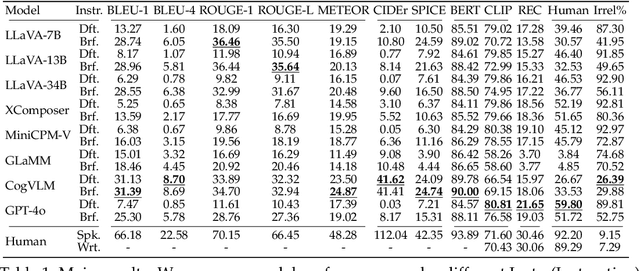

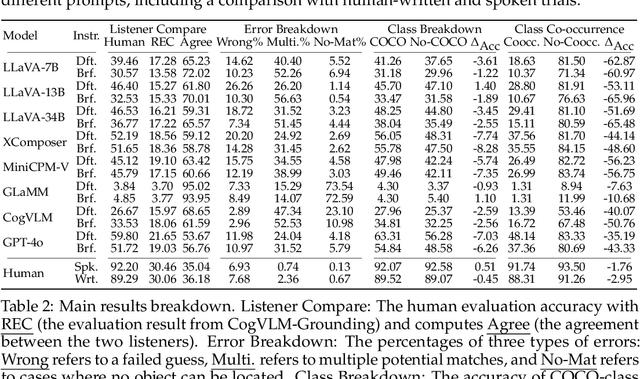
Abstract:Referring Expression Generation (REG) is a core task for evaluating the pragmatic competence of vision-language systems, requiring not only accurate semantic grounding but also adherence to principles of cooperative communication (Grice, 1975). However, current evaluations of vision-language models (VLMs) often overlook the pragmatic dimension, reducing REG to a region-based captioning task and neglecting Gricean maxims. In this work, we revisit REG from a pragmatic perspective, introducing a new dataset (RefOI) of 1.5k images annotated with both written and spoken referring expressions. Through a systematic evaluation of state-of-the-art VLMs, we identify three key failures of pragmatic competence: (1) failure to uniquely identify the referent, (2) inclusion of excessive or irrelevant information, and (3) misalignment with human pragmatic preference, such as the underuse of minimal spatial cues. We also show that standard automatic evaluations fail to capture these pragmatic violations, reinforcing superficial cues rather than genuine referential success. Our findings call for a renewed focus on pragmatically informed models and evaluation frameworks that align with real human communication.
VEGGIE: Instructional Editing and Reasoning of Video Concepts with Grounded Generation
Mar 19, 2025Abstract:Recent video diffusion models have enhanced video editing, but it remains challenging to handle instructional editing and diverse tasks (e.g., adding, removing, changing) within a unified framework. In this paper, we introduce VEGGIE, a Video Editor with Grounded Generation from Instructions, a simple end-to-end framework that unifies video concept editing, grounding, and reasoning based on diverse user instructions. Specifically, given a video and text query, VEGGIE first utilizes an MLLM to interpret user intentions in instructions and ground them to the video contexts, generating frame-specific grounded task queries for pixel-space responses. A diffusion model then renders these plans and generates edited videos that align with user intent. To support diverse tasks and complex instructions, we employ a curriculum learning strategy: first aligning the MLLM and video diffusion model with large-scale instructional image editing data, followed by end-to-end fine-tuning on high-quality multitask video data. Additionally, we introduce a novel data synthesis pipeline to generate paired instructional video editing data for model training. It transforms static image data into diverse, high-quality video editing samples by leveraging Image-to-Video models to inject dynamics. VEGGIE shows strong performance in instructional video editing with different editing skills, outperforming the best instructional baseline as a versatile model, while other models struggle with multi-tasking. VEGGIE also excels in video object grounding and reasoning segmentation, where other baselines fail. We further reveal how the multiple tasks help each other and highlight promising applications like zero-shot multimodal instructional and in-context video editing.
Training Turn-by-Turn Verifiers for Dialogue Tutoring Agents: The Curious Case of LLMs as Your Coding Tutors
Feb 18, 2025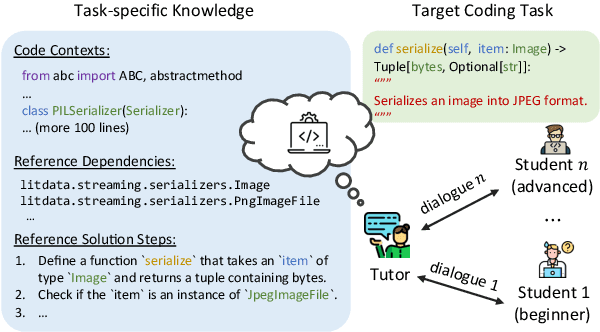
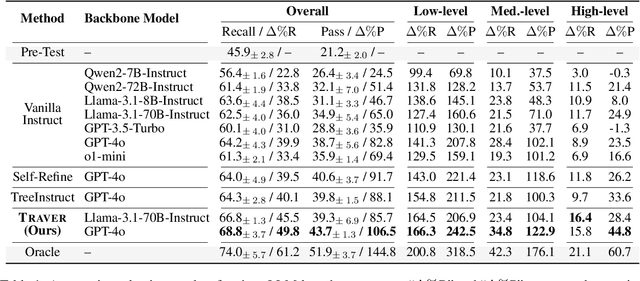
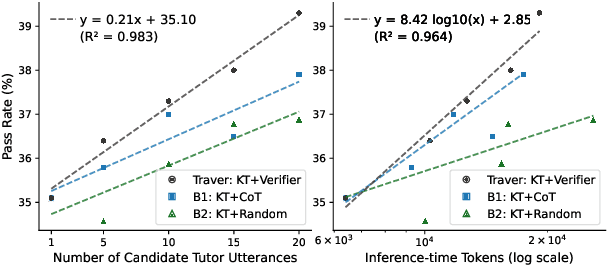

Abstract:Intelligent tutoring agents powered by large language models (LLMs) have been increasingly explored to deliver personalized guidance in areas such as language learning and science education. However, their capabilities in guiding users to solve complex real-world tasks remain underexplored. To address this limitation, in this work, we focus on coding tutoring, a challenging problem that requires tutors to proactively guide students toward completing predefined coding tasks. We propose a novel agent workflow, Trace-and-Verify (TRAVER), which combines knowledge tracing to estimate a student's knowledge state and turn-by-turn verification to ensure effective guidance toward task completion. We introduce DICT, an automatic evaluation protocol that assesses tutor agents holistically using controlled student simulation and code generation tests. Extensive experiments reveal the challenges of coding tutoring and demonstrate that TRAVER achieves a significantly higher success rate. Although we use code tutoring as an example in this paper, our results and findings can be extended beyond coding, providing valuable insights into advancing tutoring agents for a variety of tasks.
Humanity's Last Exam
Jan 24, 2025Abstract:Benchmarks are important tools for tracking the rapid advancements in large language model (LLM) capabilities. However, benchmarks are not keeping pace in difficulty: LLMs now achieve over 90\% accuracy on popular benchmarks like MMLU, limiting informed measurement of state-of-the-art LLM capabilities. In response, we introduce Humanity's Last Exam (HLE), a multi-modal benchmark at the frontier of human knowledge, designed to be the final closed-ended academic benchmark of its kind with broad subject coverage. HLE consists of 3,000 questions across dozens of subjects, including mathematics, humanities, and the natural sciences. HLE is developed globally by subject-matter experts and consists of multiple-choice and short-answer questions suitable for automated grading. Each question has a known solution that is unambiguous and easily verifiable, but cannot be quickly answered via internet retrieval. State-of-the-art LLMs demonstrate low accuracy and calibration on HLE, highlighting a significant gap between current LLM capabilities and the expert human frontier on closed-ended academic questions. To inform research and policymaking upon a clear understanding of model capabilities, we publicly release HLE at https://lastexam.ai.
Do Vision-Language Models Represent Space and How? Evaluating Spatial Frame of Reference Under Ambiguities
Oct 22, 2024Abstract:Spatial expressions in situated communication can be ambiguous, as their meanings vary depending on the frames of reference (FoR) adopted by speakers and listeners. While spatial language understanding and reasoning by vision-language models (VLMs) have gained increasing attention, potential ambiguities in these models are still under-explored. To address this issue, we present the COnsistent Multilingual Frame Of Reference Test (COMFORT), an evaluation protocol to systematically assess the spatial reasoning capabilities of VLMs. We evaluate nine state-of-the-art VLMs using COMFORT. Despite showing some alignment with English conventions in resolving ambiguities, our experiments reveal significant shortcomings of VLMs: notably, the models (1) exhibit poor robustness and consistency, (2) lack the flexibility to accommodate multiple FoRs, and (3) fail to adhere to language-specific or culture-specific conventions in cross-lingual tests, as English tends to dominate other languages. With a growing effort to align vision-language models with human cognitive intuitions, we call for more attention to the ambiguous nature and cross-cultural diversity of spatial reasoning.
Vision-and-Language Navigation Today and Tomorrow: A Survey in the Era of Foundation Models
Jul 09, 2024


Abstract:Vision-and-Language Navigation (VLN) has gained increasing attention over recent years and many approaches have emerged to advance their development. The remarkable achievements of foundation models have shaped the challenges and proposed methods for VLN research. In this survey, we provide a top-down review that adopts a principled framework for embodied planning and reasoning, and emphasizes the current methods and future opportunities leveraging foundation models to address VLN challenges. We hope our in-depth discussions could provide valuable resources and insights: on one hand, to milestone the progress and explore opportunities and potential roles for foundation models in this field, and on the other, to organize different challenges and solutions in VLN to foundation model researchers.
 Add to Chrome
Add to Chrome Add to Firefox
Add to Firefox Add to Edge
Add to Edge